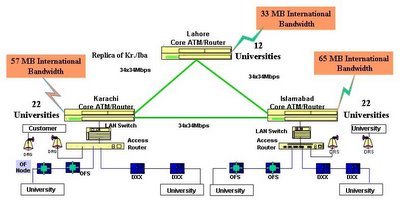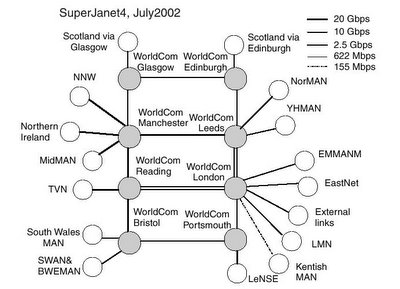Welcome to the Grid Computing Blog in which we talk about Grid Computing, Utility Computing and related commentary, news and latest developments.
Wednesday, November 16, 2005
A Day in the Life: Grid Computing: Adoption Realities
Grid Computing and Industry
Some of the links that prompted me to write this blog are:
Keeping an eye on Apple's Grid computing efforts
Microsoft High-Performance Computing Strategy
Platform Computing and IBM Push the Boundaries of Supercomputing Performance
Grid Computing and Clustering -- the next OS battleground
Grid Standards Groups Weigh Merger
See complete story here: http://news.taborcommunications.com/msgget.jsp?mid=508707
This is a very good development as we will see more collaboration between industry and academia as well as standardization.
Monday, November 14, 2005
Pakistan Education and Research Network (PERN)
Even though the networking requirement of most real grid applications are much more than provided by PERN, a developing country like Pakistan can not afford to have another dedicated high-speed network. So, PERN would be our starting point to any real grid computing implementation in Pakistan.
PERN utilizes the existing Optical Fiber System (OFS) of Pakistan Telecommunication Private Limited (PTCL) and National Telecommunication Limited (NTC) and IP/ATM backbone of NTC is utilized for the core network of PERN. The network design of PERN consists of three nodal points at Islamabad, Lahore and Karachi as shown in figure below. Most educational institutions are connected to their respective nodal point by a 256 Kb/s to 6Mbps link from the nearest exchange of NTC/PTCL using OFS, DXX, DRS or VSAT, whichever is technically feasible.

According to PERN website, the current interconnection of three main nodes is on 34x34 Mbps and Internet connectivity is 65 Mbps for Islamabad, 33 Mbps for Lahore and 57 Mbps for Karachi. This architecture allows institutions to pool resources with each other through national fiber network and to access Internet from the respective nodal points. The bandwidths provisioned and planned through the PERN network for various universities can be found on PERN website.
In order to elaborate the differences between PERN and similar networks of developed countries, the following is the architecture of the United Kingdom National Backbone Research and Education Network (see the figure below). The figure especially shows differences in speed and reliability of the two networks.

Comments on the design, performance and architecture of PERN are welcome as I am in the process of collecting and consolidating views from the industry people on this topic.
Sunday, November 13, 2005
EPSRC Funded PhD Studentship in Grid Computing
The Sensors, Instrumentation and Radiation Effects (SIRE) research group invites applications for an EPSRC funded studentship with immediate effect.
The SIRE group has a broad research programme in the areas of experimental particle physics, developing detectors, and grid/distributed computing.
The LHC (Large Hadron Collider) in Geneva, Switzerland is about to begin an exciting and cutting edge experiment in the world. It is projected to produce tens of petabytes of data per year from 2007. This huge data will require extensive distributed Grid technologies to analyse and store it (LHC Computing Grid, http://lcg.web.cern.ch/LCG/).
The group is also working on a running experiment at SLAC (Stanford Linear Accelerator Center) called BaBar which is producing and analysing large amount of data on B mesons. Currently, it uses the largest object database in the world (800TB+).
The successful candidate can contribute directly to developing Grid Middleware for the LCG or e-Science projects, working with worldwide expects on Grid Computing at RAL (Rutherford Appleton Lab), CERN in Gevena and SLAC at Stanford University in California. He/she will have a chance to attend short and long term visits at these research labs.
Candidates should have a good honours degree in Physics, Computer Science, or related numerate subject. It would be beneficial to have a keen interest in computing: in particular Java/C++, the Linux operating system and distributed/Grid computing
Applications with a CV and informal inquiries should be directed to:
Dr Akram Khan
email: akram@slac.stanford.edu
Sunday, November 06, 2005
Ten Technologies to watch in 2006
0,289142,sid19_gci1137889,00.html
Gartner Inc.'s 2006 Top 10 Strategic Technologies list holds out lots of hope, not just hype, for virtualization and grid computing, among others. Analysts Carl Claunch and David Cearley are predicting these technologies will be mature enough to offer value in the next 18 to 36 months, and that means they should be on your list of technologies to research -- or adopt -- in the coming year.
Lists the following:
- Virtualization
- Grid computing
- Service-oriented business applications (SOBAs)
- Pervasive computing
- OLED/LEP technologies
- Location-aware services
- Linux
- Desktop search tools
- Microcommerce
- Instant messaging
http://searchcio.techtarget.com/originalContent/
0,289142,sid19_gci1137889,00.html